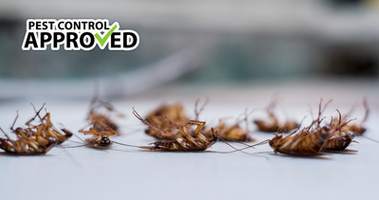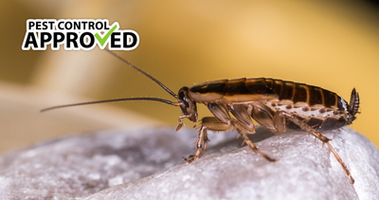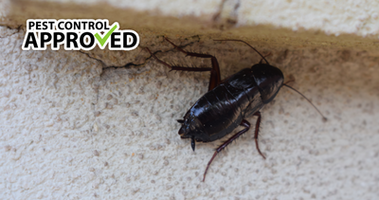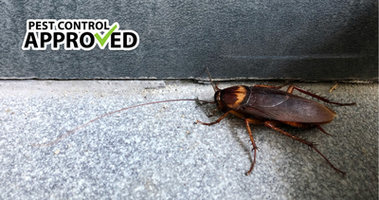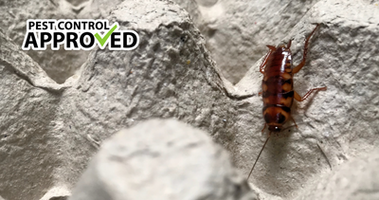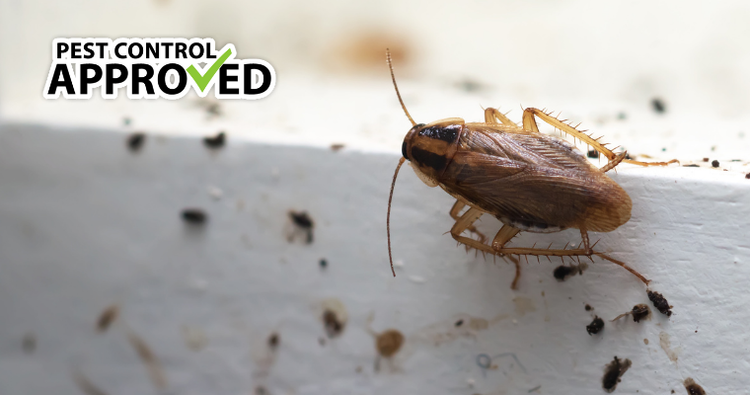
German Cockroaches
When most people picture a cockroach, they are picturing a German cockroach. They are the most troublesome species as they infest restaurants, hotels, and nursing homes, causing allergies and illness. They group together and are known to change their habits to avoid predators, including humans. They are related to the Asian cockroach, but they cannot fly. Like most species, they are nocturnal and need an easy source of water.
NAME: Blattella germanica
LOCATION: Worldwide
HABITAT: Warm climates
DIET: Omnivore
SIZE: ½” to 5/8”
PREDATORS: birds, reptiles
LIFE EXPECTANCY: 100 days
Size
German cockroaches are one of the smaller cockroach species although they are bigger than the brown-banded cockroach at 1/2 to 5/8” long. They are smaller than the American, Oriental, and Smoky Brown cockroach.
Appearance
German cockroaches are light brown to tan. They have two dark parallel lines running down the back of their head. They have three sections: head, thorax, and abdomen. Their head contains two straight antennae and their mouth parts. The thorax contains their six legs and wings. They are generally flat and oval in shape. Male German cockroaches are thin with full wings and their abdomen is covered completely by their wings. Females are rounder with shorter wings. Our Complete Guide to Cockroaches will go over more details on appearance, diets, and treatment options.
Diet
German cockroaches have a wide and varied diet. Outdoors, they eat fungi, dead insects, and plant matter. Indoors, they eat whatever is available. They will eat anything resembling food, but they prefer sweets, meats, and starches. They will also eat hair, books, soap, glue, and decaying matter. They can survive for days without water and months without food.
Habitat
German cockroaches spend most of their lives hidden. Only about 25% of their lives is outside of their hiding spots. They are usually found in areas with abundant food and water like kitchens and bathrooms. Because they are invasive to the United States, they cannot easily survive outside. But in the southern states, they can live outside in the summer months. If outside, they will move indoors in winter. However, in most places they live indoors year-round. They are frequently found in restaurants and food processing plants. German cockroaches also often inhabit hotels and nursing homes. They can easily spread via grocery bags, boxes, and second-hand items. Remember, even finding one cockroach inside your home is grounds for treatment, don't wait to long or the infestation can quickly multiply.
Reproduction
Female German cockroaches, like all cockroaches, lay an egg case which contains multiple eggs. This egg case protects the eggs from the elements, predators, and pesticides. Each egg case has 30 to 40 eggs. The egg case is tiny, brown, and purse shaped. It is about 5/16th inches long, 1/8th high, and 5/64th wide. Female German cockroaches carry their egg case around until just before hatching. Then, they remove it from their abdomen and place it in a hidden spot one day before hatching begins. Nonetheless, nymphs sometimes hatch while the egg case is still attached to her body. Nymphs are initially white but turn dark brown quickly. They mold around six times before they reach adulthood. This takes about 60 days. Nymphs are able to hunt for food and water soon after they hatch. Check out our guide on Baby Cockroaches and how to eliminate them.
Predators
Cockroaches are preyed on by a variety of animals including reptiles, birds, and other insects. Outside North America, hedgehogs are a common predator of cockroaches. In the Southern USA, reptiles are the biggest thread. Toads, frogs, lizards, and geckos are adept at catching and eating cockroaches. However, in parts of the United States, the weather is too cold for many reptiles. Rodents are more likely to eat cockroaches in colder areas. While mice can eat them, rats are known for eating cockroaches. They can even eat them off of glue traps! They are able to skillfully eat them without getting caught in the glue.
In Northern states, the most likely predator of cockroaches are birds. Starlings are large enough to eat cockroaches and need insects to be able to breed. Chickens are also great bug catchers and can eat lots of cockroaches if given the opportunity.
Parasitic wasps are known to lay their eggs inside the cockroach egg capsule. The newly hatched wasps will eat either the young larva or eat the nourishing egg fluids, starving the cockroach larva. The exact nature of these wasps depends on the species.
Lifespan
German cockroaches have a short lifespan, but they are able to reproduce rapidly. They live less than a year, generally between 100 and 200 days from birth until death.
Roaches are one of the hardest pests to eliminate. Browse our list of Top Rated Exterminators in your area, ready to assist.


